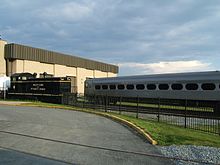Pioneer III
| PRR MP85 / Silverliner I | |
|---|---|

Pioneer II #247 at Strasburg in 2006
|
|
| In service | 1958–90 |
| Manufacturer | Budd Company |
| Built at | Red Lion Plant, Philadelphia |
| Family name | Pioneer III |
| Number built | 6 |
| Formation | Single unit |
| Fleet numbers | PRR 150-155 PC / SEPTA 244-248 |
| Operator(s) |
Pennsylvania Railroad Penn Central Railroad Conrail SEPTA |
| Specifications | |
| Maximum speed | 85 mph (137 km/h) |
| Weight | 90,000 pounds (41,000 kg) |
| Traction system | Line current transformed to 1580V and fed through 4 Westinghouse WL653B Ignitron rectifiers to a DC resistance motor controller. 2 cars converted to silicon rectifier in 1961. |
| Power output | 400 hp (300 kW) (4 x 100 hp (75 kW) ) |
| Electric system(s) | 12,000 V 25 Hz AC catenary |
| Current collection method | Pantograph |
| Bogies | Budd Pioneer |
| Braking system(s) | Pneumatic |
The Pioneer III railcar was a short/medium distance coach designed and built by the Budd Company in 1956 with an emphasis on weight savings. A single prototype was built, but declines in rail passenger traffic resulted in a lack of orders so Budd re-designed the concept as an electric multiple unit (m.u.). Six of the EMU coach design were purchased by the Pennsylvania Railroad with the intention of using them as a high-speed self-contained coach that could be used for long-distance commuter or short-distance intercity travel in the Northeast U.S. The 6 production Pioneer III units were the first all stainless steel bodied EMU railcar built in North America and at 90,000 pounds (41,000 kg), the lightest.
The Pioneer III lightweight coach (Budd serial number 3880) was completed in 1956 and was seen by the Budd Company as a milestone product that could revolutionize the passenger railcar market. With this assessment in mind, the Pioneer III name was chosen in reference to the Budd Pioneer stainless steel aircraft and the Pioneer Zephyr lightweight trainset. The coach was designed for medium or short distance inter-city passenger travel with extreme emphasis placed on saving weight. This was accomplished through the use of electric train heat and air conditioning in place of steam and mechanical systems, high-speed inboard bearing trucks that used air suspension instead of heavier springs, an airline-style bathroom instead of the fully equipped "lounge" style and a thin stainless steel carbody. The result was a car that weighed only 53,000 pounds (24 t), nearly half the amount of the then state-of-the-art "lightweight" stainless steel cars being manufactured by Budd. With a capacity of 88 passengers in a 2+2 seating configuration, the Pioneer III coach achieved a 600 pounds (270 kg) weight-to-passenger ratio, a number not seen since the days when passenger cars had been made out of wood. Unfortunately, these remarkable statistics were accomplished at the expense of comfort, as passengers were provided with significantly reduced legroom compared to other coaches in the same class and a bouncier ride.
...
Wikipedia
